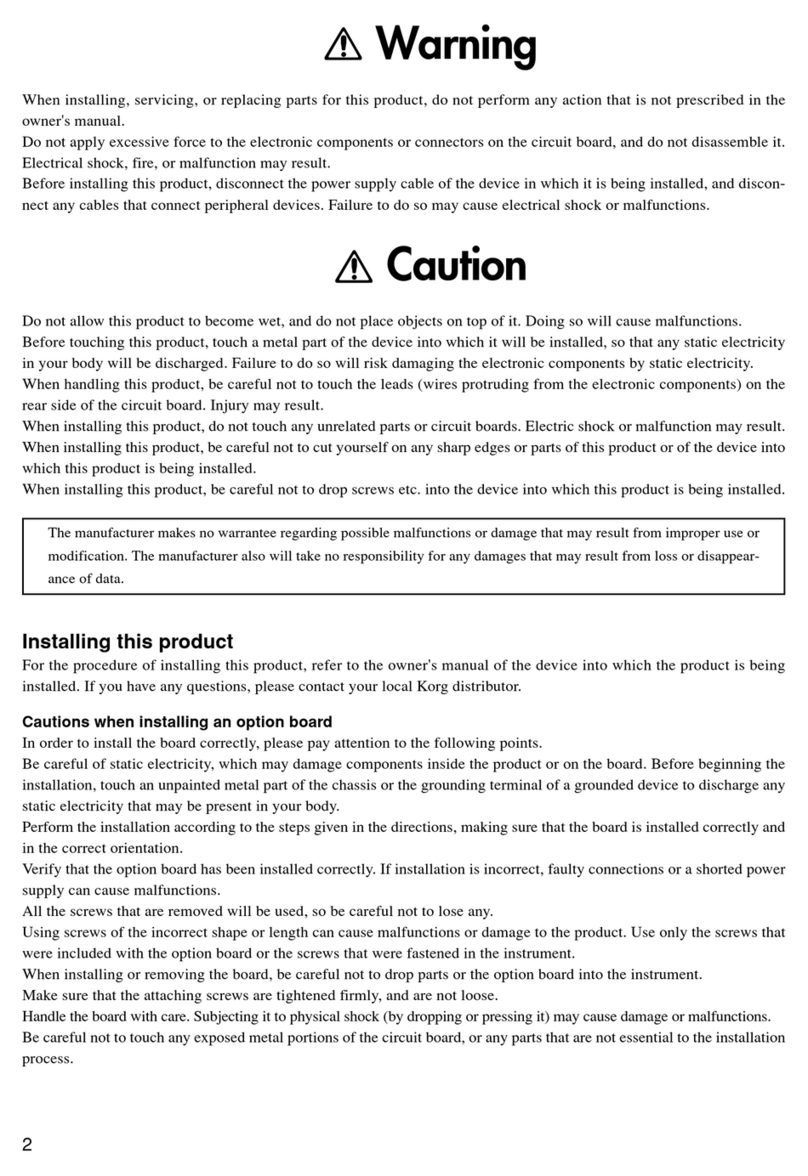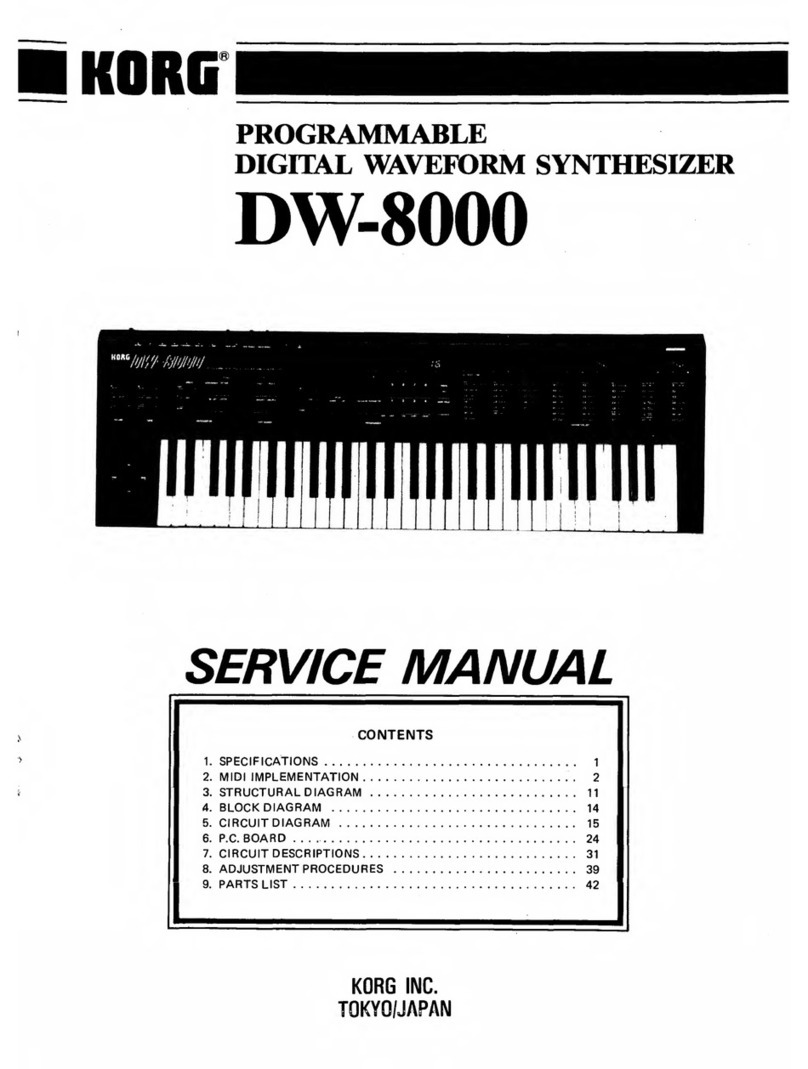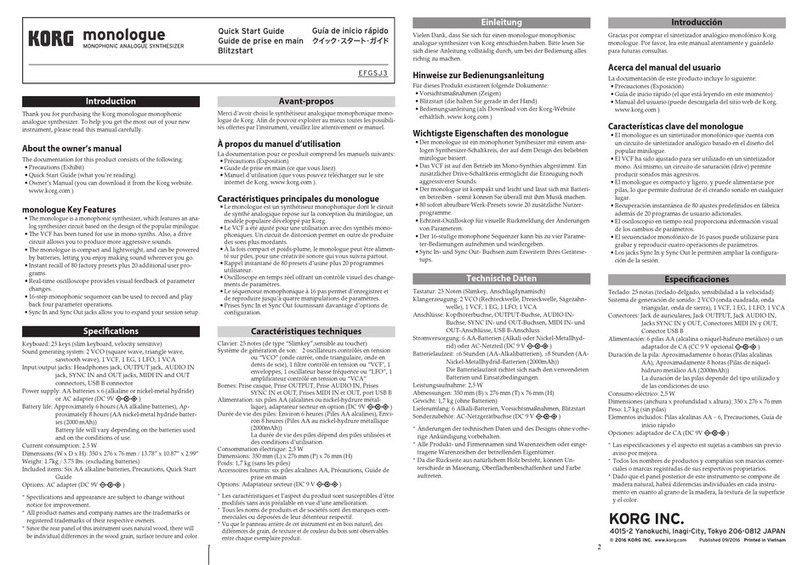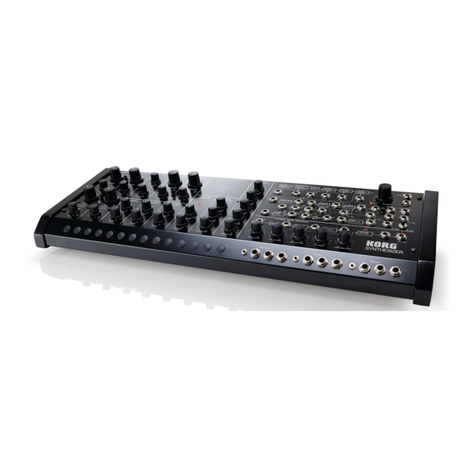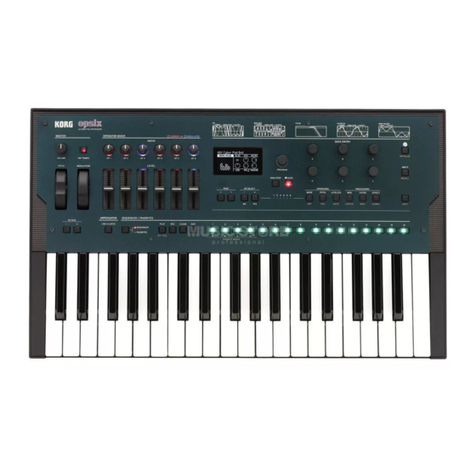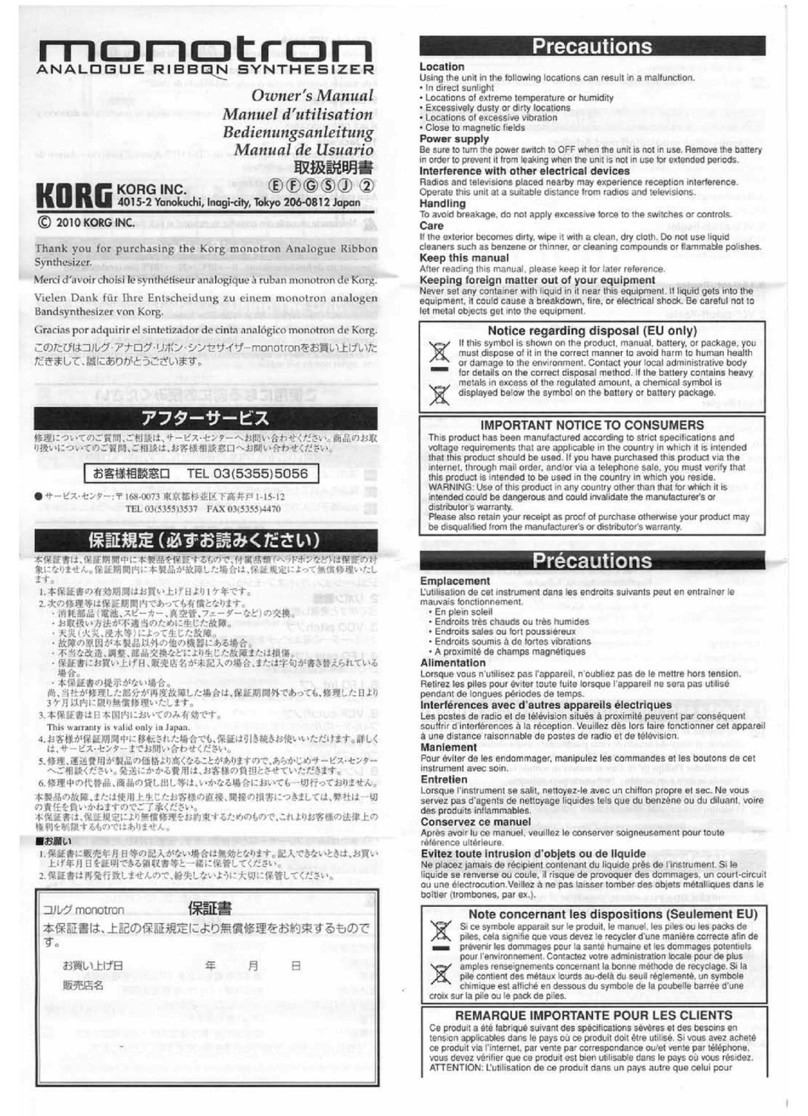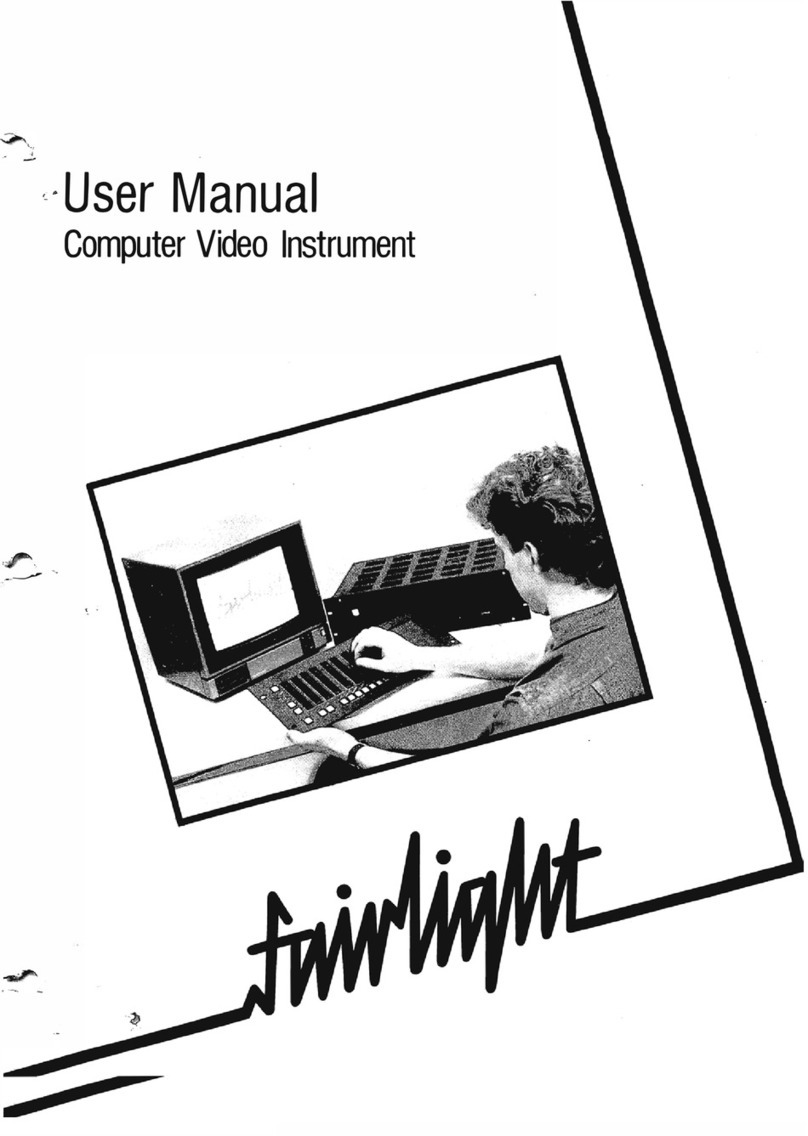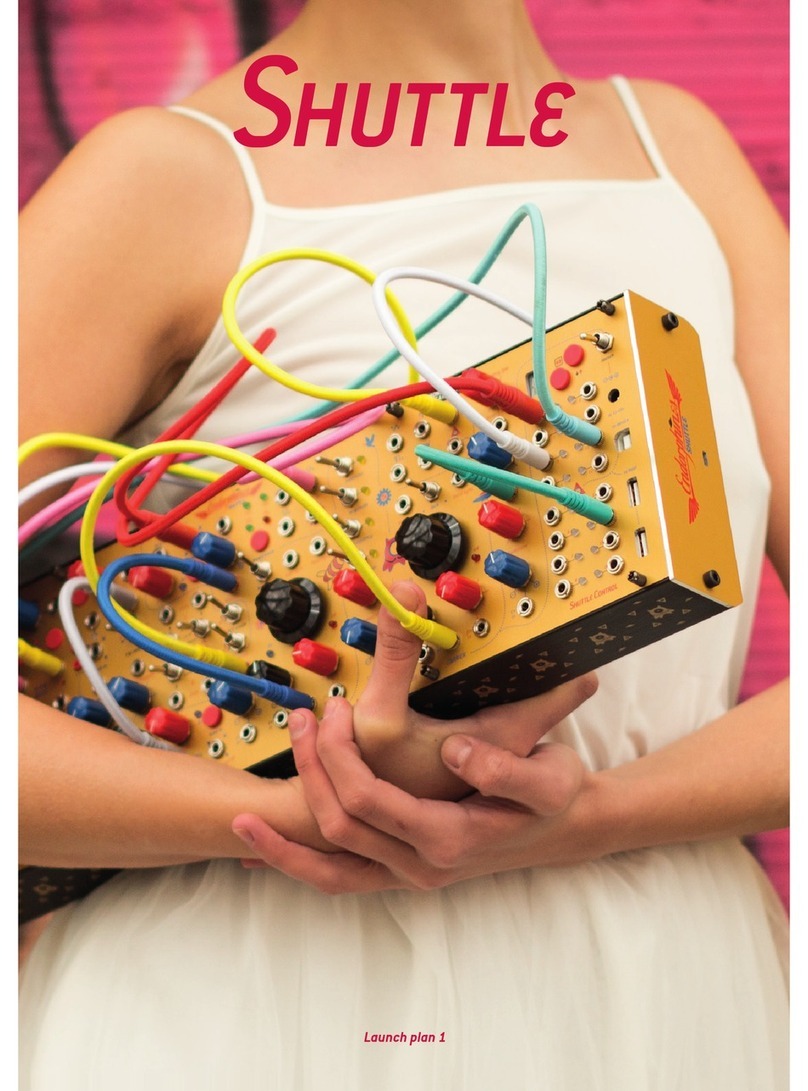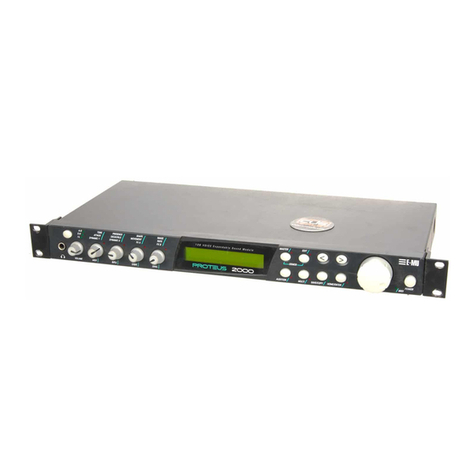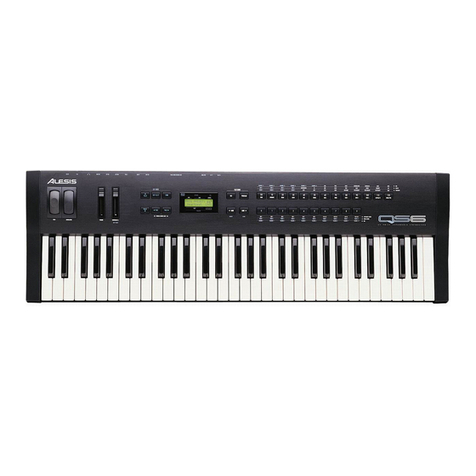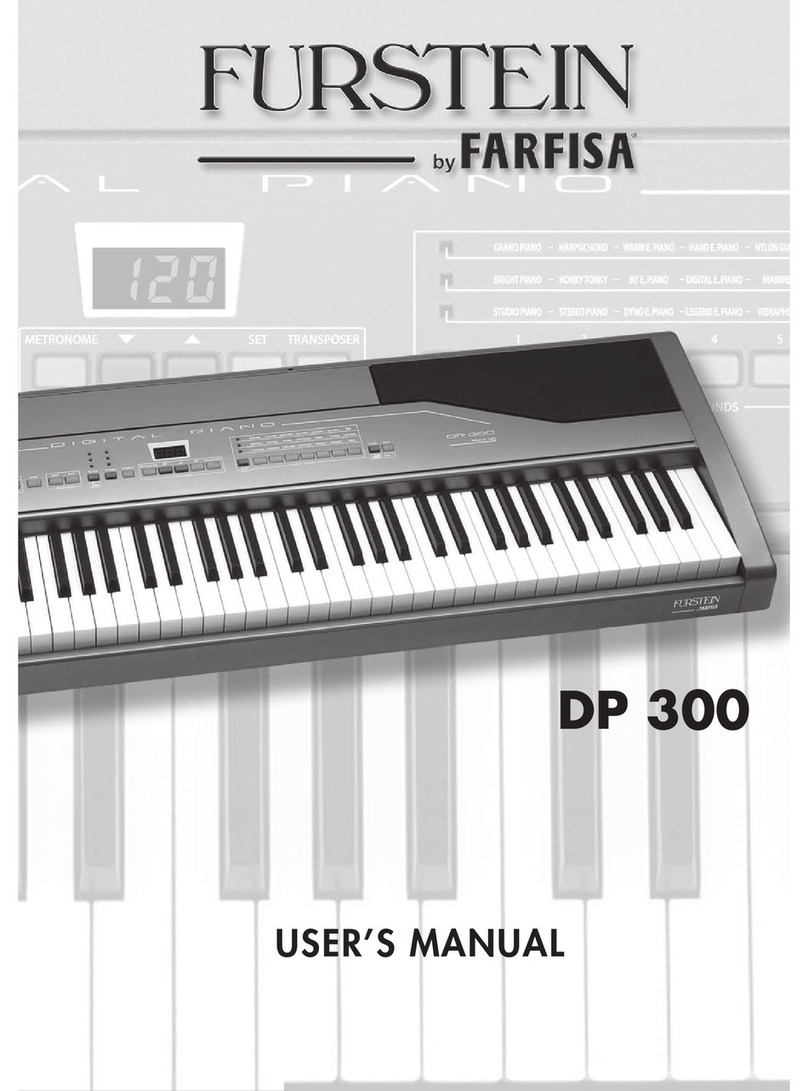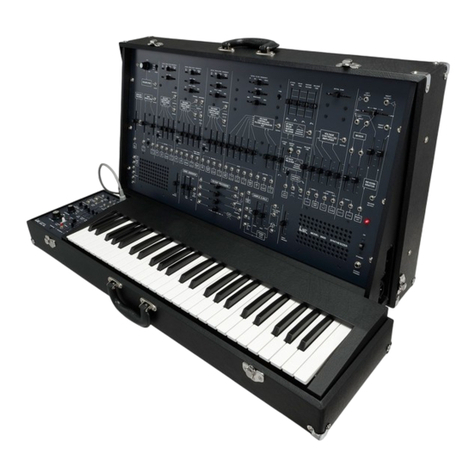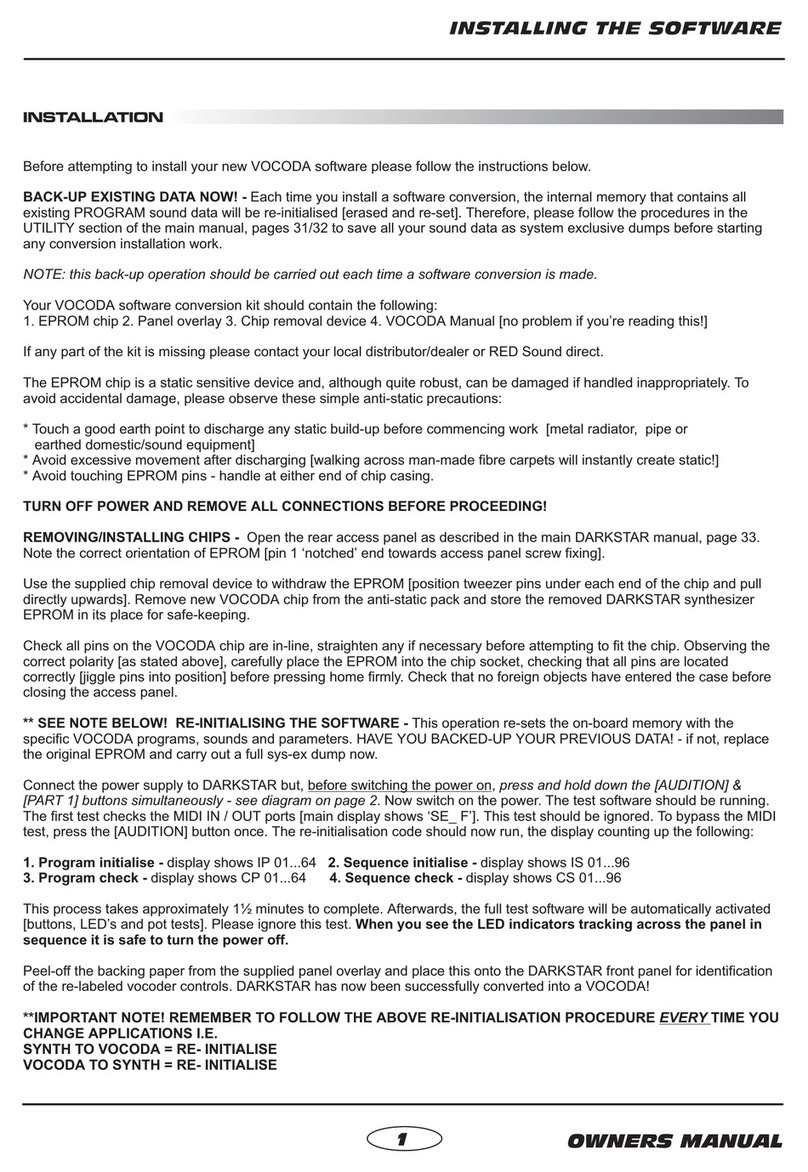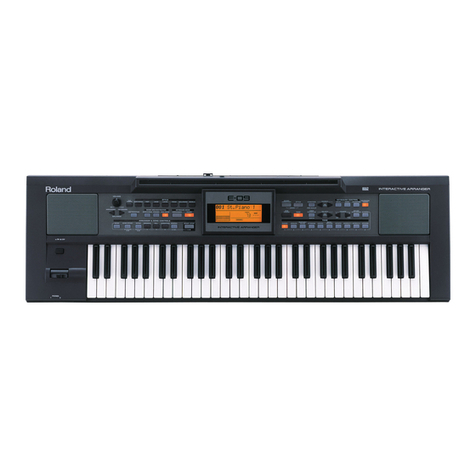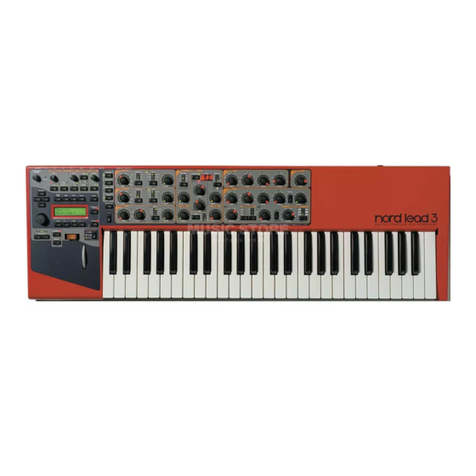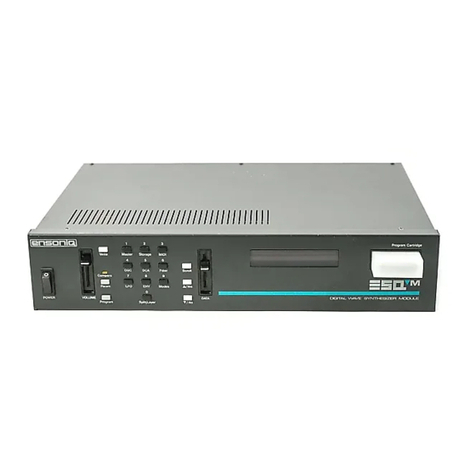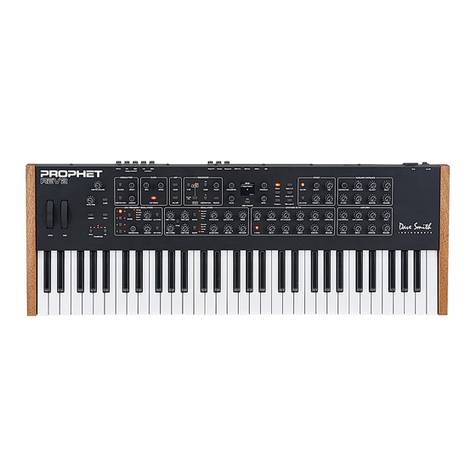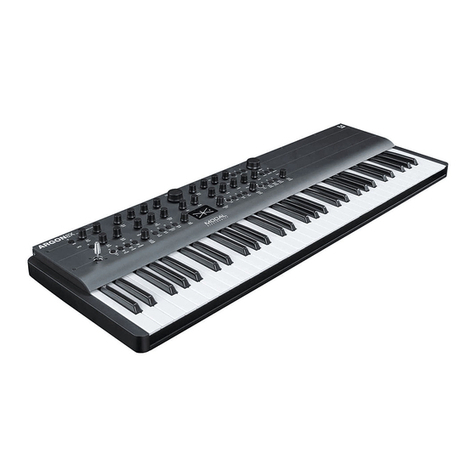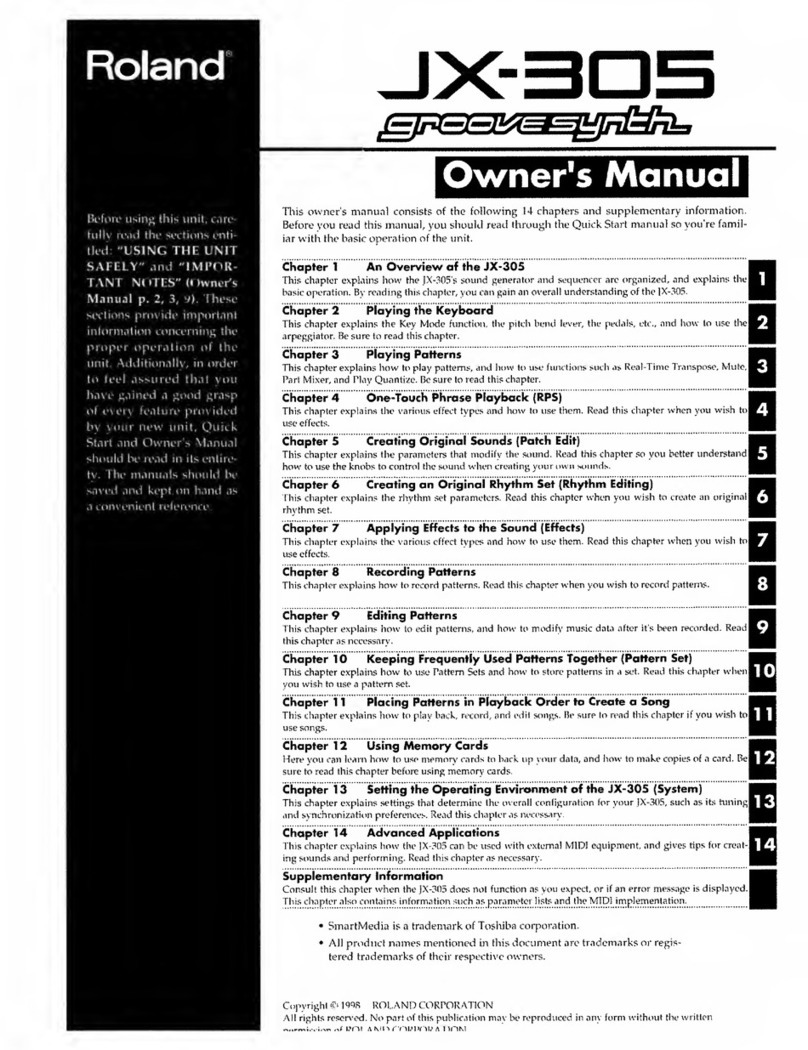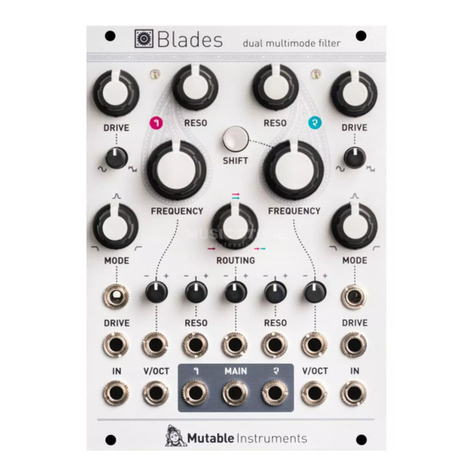Korg Kaosilator User manual

Precautions
Location
Using the unit in the following locations can result in a
malfunction.
•In direct sunlight
•Locations of extreme temperature or humidity
•Excessively dusty or dirty locations
•Locations of excessive vibration
•Close to magnetic fields
Power supply
Please connect the designated AC adapter to an AC out-
let having the correct voltage. Do not connect it to an AC
outlet having a voltage other than that specified for your
unit.
Interference with other electrical devices
Radios and televisions placed nearby may experience
reception interference. Operate this unit at a suitable dis-
tance from radios and televisions.
Handling
To avoid breakage, do not apply excessive force to the
switches or controls.
Care
If the exterior becomes dirty, wipe it with a clean, dry cloth.
Do not use liquid cleaners such as benzene or thinner, or
cleaning compounds or flammable polishes.
Keep this manual
After reading this manual, please keep it for later refer-
ence.
Keeping foreign matter out of your equipment
Never set any container with liquid in it near this equip-
ment. If liquid gets into the equipment, it could cause a
breakdown, fire, or electrical shock.
Be careful not to let metal objects get into the equipment.
If something does slip into the equipment, unplug the AC
adapter from the wall outlet. Then contact your nearest
Korg dealer or the store where the equipment was pur-
chased.
THE FCC REGULATION WARNING (for USA)
This equipment has been tested and found to comply
with the limits for a Class B digital device, pursuant to
Part 15 of the FCC Rules. These limits are designed to
provide reasonable protection against harmful interfer-
ence in a residential installation. This equipment gener-
ates, uses, and can radiate radio frequency energy and,
if not installed and used in accordance with the instruc-
tions, may cause harmful interference to radio commu-
nications. However, there is no guarantee that interfer-
ence will not occur in a particular installation. If this equip-
ment does cause harmful interference to radio or televi-
sion reception, which can be determined by turning the
equipment off and on, the user is encouraged to try to
correct the interference by one or more of the following
measures:
•Reorient or relocate the receiving antenna.
•Increase the separation between the equipment and
receiver.
•Connect the equipment into an outlet on a circuit dif-
ferent from that to which the receiver is connected.
•Consult the dealer or an experienced radio/TV techni-
cian for help.
Unauthorized changes or modification to this system can
void the user’s authority to operate this equipment.
Notice regarding disposal (for EU)
If this “crossed-out wheeled bin” symbol is shown
on the product or in the operating manual, you
must dispose of the product in an appropriate
way. Do not dispose of this product along with
your household trash. By disposing of this prod-
uct correctly, you can avoid environmental harm or health
risk. The correct method of disposal will depend on your
locality, so please contact the appropriate local authori-
ties for details.
4015-2 Yanokuchi, Inagi-city, Tokyo 206-0812 Japan
2007 KORG INC.
Connections
LINE OUT
DC4.5V
MIXER
AC
Option: AC ADAPTER
PHONES
Liaisons
Anschlüsse
AC Adapter (sold separately)
Connect the optional AC adapter to the DC 4.5 V jack.
Be sure to set the ON/STANDBY switch to the STANDBY
position before connecting the AC adapter.
Be sure to use only the specified AC adapter.
Adaptateur secteur (vendu séparément)
Branchez l’adaptateur secteur optionnel sur la prise DC 4.5 V.
N’oubliez pas de régler le commutateur ON/STANDBY sur la
position STANDBY avant de brancher l’adaptateur secteur.
Veillez à utiliser seulement l’adaptateur secteur spécifié.
Netzteil (getrennt erhältlich)
Schließen Sie das optionale Netzteil an die Buchse DC 4.5V an.
Stellen Sie den ON/STANDBY-Schalter auf STANDBY, be-
vor Sie das Netzteil anschließen.
Verwenden Sie nur das vorgeschriebene Netzteil.
IMPORTANT NOTICE TO CONSUMERS
This product has been manufactured according to strict
specifications and voltage requirements that are ap-
plicable in the country in which it is intended that this
product should be used. If you have purchased this
product via the internet, through mail order, and/or via
a telephone sale, you must verify that this product is
intended to be used in the country in which you reside.
WARNING: Use of this product in any country other
than that for which it is intended could be dangerous
and could invalidate the manufacturer’s or distributor’s
warranty.
Please also retain your receipt as proof of purchase
otherwise your product may be disqualified from the
manufacturer’s or distributor’s warranty.
Specifications
Connectors:
LINE OUT jacks (RCA jacks), PHONES
jack (Stereo mini phone jacks)
Power supply:
four alkaline AA (LR6) batteries (6 V)
Battery life: approximately five hours (with alka-
line batteries)
Dimensions: 106 mm (W) x 129 mm (D) x 29 mm
(H) / 4.17" (W) x 5.08" (D) x 1.14" (H)
Weight: 163 g / 5.75 oz. (without batteries)
Included items: owner’s manual, parameter sheet,
four AA “test” batteries
Options (sold separately):
AC adapter ( , DC4.5V )
* Specifications and appearance are subject to change without
notice for improvement.
* All other product and conpany names are trademarks or
registerd trademarks of their respective holders.

Operation
Volume knob
The VOLUME knob affects only the headphone volume.
The VOLUME knob will not affect the LINE OUT volume.
Selecting a program
Turn the PROGRAM/VALUE knob to select one of the 100
programs, from *.00–*.99 (* indicates the category).
Playing the touch pad
Move your finger around on (or tap on) the touchpad to control
the sound. The parameters controlled by the X axis and Y axis
are shown on the PROGRAM LIST.
Touching the extreme outer edges won’t control the sound.
Using the gate arpeggiator
Press the GATE ARP button; the GATE ARP indicator will light.
Now when you play the touch pad, the KAOSSILATOR will
“gate” the sound using the currently selected gate arpeggiator
pattern.
Selecting a gate arpeggiator pattern
1. Press and hold the GATE ARP button; the display will indi-
cate the currently selected pattern number [ ].
2. Turn the PROGRAM/VALUE knob to select a gate
arpeggiator pattern from G.00–G.49.
3. Press and hold the GATE ARP button again and the
KAOSSILATOR will switch back to the program selection
state.The KAOSSILATOR will also return to the program se-
lection state automatically after five seconds, if no additional
setting operations are performed.
The Arp cannot be applied to certain programs—please re-
fer to the PROGRAM LIST.
Turning the power off reverts to the default value [ ].
Selecting the scale
1. Press the SCALE button; the display will indicate the abbre-
viation of the currently selected scale.
2. Turn the PROGRAM/VALUE knob to select the scale.
3. Press the SCALE button again and the KAOSSILATOR will
switch from the scale setting back to the program selection
state.The KAOSSILATOR will also return to the program se-
lection state automatically after five seconds, if no additional
setting operations are performed.
The Scale cannot be applied to certain programs—please
refer to the PROGRAM LIST.
Turning the power off reverts to the default value [ ]
(Ionian).
Selecting the key (root note/octave)
1. While holding down the SCALE button, press the TAP but-
ton; the display will indicate the current key.
C4=[ ], C#4=[ ], C3=[ ], C5=[ ]
2. Turn the PROGRAM/VALUE knob to select the key.
3. While the display is still showing the Key Select function,
press the TAP button again with the SCALE button de-
Thank you for purchasing Korg’s KAOSSILATOR dynamic
phrase synthesizer. In order to enjoy your KAOSSILATOR,
please read this owner’s manual carefully and retain it for fu-
ture reference.
KAOSSILATOR Controls & Jacks
PROGRAM/VALUE knob
LOOP STATUS indicator
Display
LINE OUT jacks
DC jack
VOLUME
PHONES jack
Touch pad
GATE ARP button
GATE ARP indicator
ON/STANDBY switch LOOP REC/PLAY button
SCALE button
TAP/BPM button
Changing the Batteries
The display will indicate “Lo” when the batteries are running
low. When this occurs, please replace the batteries as soon as
possible.
“Test” batteries are provided so that you can verify that
your KAOSSILATOR operates properly. These batteries may
have a shorter than expected lifespan .
When the batteries become unusable, remove them imme-
diately. You should also remove the batteries if you won't be
using the unit for an extended period of time.
1. Set the ON/STANDBY switch to the STANDBY position.
2. Slide the battery case cover
on the bottom panel in the di-
rection of the arrow to open it.
3. Install four AA batteries (Use
alkaline only).
Note the polarity (+, -) and be
sure the batteries are inserted
with the correct orientation.
4. Close the battery case cover.
Turning the power on/off
Turning the power on
Set the ON/STANDBY switch to the ON position.
Turning the power off
Set the ON/STANDBY switch to the STANDBY position.
If you're using the KAOSSILATOR on battery power, don't
forget to turn the power off when you are through using it.
pressed, the KAOSSILATOR will switch from the key setting
back to the program selection state. The KAOSSILATOR will
also return to the program selection state automatically af-
ter five seconds, if no additional setting operations are per-
formed.
When applying a Key to certain Programs, noise may oc-
cur or no sound may be produced.
Turning the power off reverts to the default value [ ].
Setting the BPM
1. Press the TAP button; the current BPM setting will be dis-
played.
2. Manual: Turn the PROGRAM/VALUE knob while the BPM
setting is displayed to change the BPM setting.
3. Tap Tempo: Hit the TAP button several times in tempo with
your song, the detected BPM will be used as the current set-
ting.
4. Press and hold the TAP button and the KAOSSILATOR will
switch from the BPM setting back to the program selection
state.The KAOSSILATOR will also return to the program se-
lection state automatically after five seconds, if no additional
setting operations are performed.
Turning the power off reverts to the default value [120].
Loop (Phrase) recording
The KAOSSILATOR can record and playback phrases and
patterns that you play on the touch pad - loop style. During
playback, you can play along.You can even add another layer
to the loop recording. This process can be repeated, adding
new layers. Phrases Can be up to 8 beats (2 bars of 4/4) in
length.
1. Press and hold the LOOP REC/PLAY button. The LOOP
STATUS indicator will light red and you can record by play-
ing the touchpad.
2. When you release the LOOP REC/PLAY button, the LOOP
STATUS indicator will light green. Playback will continue, but
recording will stop.
3. If you press the LOOP REC/PLAY button during loop play-
back, the LOOP STATUS indicator will go out and playback
will stop.
4. If you press the LOOP REC/PLAY button while playback is
stopped, the LOOP STATUS indicator will light green, and
the recorded phrase will start.
Overdubbing (layering) recorded phrases
Once you have recorded a phrase, you can play along, or you
can add another layer on top (overdub) of the recorded phrase.
Once you get a layered phrase that you like, you can save it.
That way, if you add additional layers that you don’t like, you
can go back and start again from this last saved version.
1. If you hold down the LOOP REC/PLAY button for an ex-
tended period of time after the phrases are recorded, [ ]
(Stopped) or [ ] (Playback: the numerical figure shows
the beat position) will be displayed.
2. Continue to hold down the LOOP REC/PLAY button and turn
the PROGRAM/VALUE knob so that [ ] (Fix) appears in
the display. When you release the LOOP REC/PLAY button,
the recorded phrase/layers are saved.
3. Press and hold the LOOP REC/PLAY button to start record-
ing as you make new layers.
4. If you do not like the new phrases, continue to hold down the
LOOP REC/PLAY button and turn the PROGRAM/VALUE
knob so that [ ] (Cancel) appears in the display. When
you release the LOOP REC/PLAY button, only the newly re-
corded phrases will be deleted.
5. If you want to merge the newly recorded phrases with the
saved phrases, continue to hold down the LOOP REC/PLAY
button and turn the PROGRAM/VALUE knob so that [ ]
appears on the display. When you release the LOOP REC/
PLAY button, the newly recorded phrases will be mixed with
the saved phrases.
6. To delete all recorded phrases and layers, continue to hold
down the LOOP REC/PLAY button and turn the PROGRAM/
VALUE knob so that [ ] (Clear) appears in the display.
When you release the LOOP REC/PLAY button, all phrases
including the saved phrases will be completely deleted.
The display blinks and the LOOP STATUS indicator lights
orange while each process is being performed.
When the power is turned off, all recorded phrases includ-
ing the saved phrases will be deleted.
Deleting elements of recorded phrases
During playback, if you hold down the LOOP REC/PLAY but-
ton and press the SCALE button, the phrase elements played
when the SCALE button is depressed will be deleted. During
this operation, [ ] (Deleting: the numerical figure shows the
beat position) will appear in the display.
In addition, if you press the SCALE button while you are record-
ing sounds with the LOOP REC/PLAY button depressed dur-
ing playback of the recorded phrase, the reproduced phrases
previously recorded will be replaced with new ones. [ ] will
appear on the display.
The operations above don't delete the saved phrases.
Setting the length of each phrase
1. While holding down the LOOP REC/PLAY button, press the
TAP button. The display will indicate the current phrase
length for recording and playback.
[] =1/16, [ ] =1/8, [ ] =1/4, [ ] =1/2
[] =1, [ ] =2, [ ] =4, [ ] =8
2. Turn the PROGRAM/VALUE knob to set the phrase length
for recording and playback.
3. If you press the TAP button again with the LOOP REC/PLAY
button depressed, the KAOSSILATOR will switch from the
length setting back to the program selection state. The
KAOSSILATOR will also return to the program selection
state automatically after fifteen seconds, if no additional set-
ting operations are performed.
When the BPM setting is between 20 and 37.5, the actual
length for recording and playback will be 1/4 of the indicated
length. When the BPM setting is between 37.5 and 75.0, the
actual length for recording and playback will be 1/2 of the indi-
cated length.
Turning the power off reverts to the default value [ ].
PROGRAM LIST
No. Program Name X AXIS Y AXIS SCALE
GATE ARP
L.00 Ambient Lead Note Ambient Depth, Vibrato
L.01 LR 5th Lead Note Pan, Delay Cutoff
L.02 Unison Lead Note Cutoff
L.03 Tell Min Note Level
L.04 Feedback Lead Note Feedback Mod
L.05 Sync Lead Note OSC Sync Pitch
L.06 Square Bell Note Decay Time
L.07 Wide Saw Lead Note Delay&AutoPan Depth
L.08 XMod Lead Note Mod Depth
L.09 Square Lead Note Cutoff
L.10 Unison Sweep Note Cutoff
L.11 3Octave Lead Note Octave
L.12 XY Scale Note Bass Note
L.13 Wave Seq Note, Pan Sequence Speed
L.14 Digital Talk Note Formant
L.15 LFO Lead Note LFO Speed
L.16 XMod Saw Lead Note Cutoff
L.17 Flap Lead Note LFO Speed
L.18 Tape Bell Lead Note Echo Time, Feedback
L.19 Pitch Mod Lead Note Pitch Mod Depth
a.20 Trumpet Note Breath Pressure
a.21 Piano Note Velocity
a.22 Digerido Note LFO Speed
a.23 Electric Sitar Note Sound Character
a.24 Duo Strings Note 2nd Strings Level
a.25 VPM Bell Note Sound Character
a.26 Jazz Guitar Note Velocity
a.27 Tenor Sax Note Breath Pressure
a.28 Harmonica Note 2nd Reed Level
a.29 Flute Note Breath Pressure
b.30 Hoover Note Cutoff, Pitch EG
b.31 Kick Bass Note Decay Time
b.32 Reso Bass Note Cutoff
b.33 Acid Bass Note Distortion
b.34 Sync LFO Bass Note LFO Speed
b.35 Unison Bass Note Cutoff
b.36 Boost Bass Note Cutoff
b.37 XMod Bass Note Cutoff
b.38 Fall Bass Note Cutoff
b.39 VPM Bass Note Decay Time
b.40 Modulation Bass Note Mod Depth
b.41 Dark Bass Note Mod Depth
b.42 Ring Bass Note Cutoff
b.43 Square Bass Note Cutoff
b.44 Dist Saw Bass Note Cutoff
b.45 MG Bass Note Cutoff
b.46 Bit Bass Note Cutoff
b.47 Synth Bass Note Cutoff
b.48 Valve Bass Note Decay Time
b.49 Organ Bass Note 3rd Percussion
No. Program Name X AXIS Y AXIS SCALE
GATE ARP
c.50 Trance Chord Note Cutoff
c.51 Sine Chord Note Octave
c.52 Organ Chord Note Drawbar Level
c.53 Sweep Chord Note LFO Speed
c.54 Choir Chord Note Formant
c.55 Power Chord Note Sound Character
c.56 BPF Chord Note Cutoff
c.57 E.Piano Chord Note Chord (Maj7, min7)
c.58 Rave Chord Note Cutoff
c.59 Chord Hit Note Chord (Maj7, min7)
S.60 Kaoss Drone Cutoff Feedback
S.61 Rise & Fall Note Rise, Fall
S.62 Feedback Loop Feedback Filter Delay Time
S.63 L->R Note LFO Speed
S.64 Noise Filter Cutoff Resonance
S.65 8bit Game Note Pitch Mod Depth
S.66 Metal Note, Cutoff LFO Speed
S.67 Siren LFO Speed, Cutoff Pitch Mod Depth
S.68 Missile Missile, Hit Decay Time
S.69 Random Note LFO Speed
S.70 Beam Saber Modulator Note Mod Depth
S.71 Synth Looper Cutoff, Looper Speed Looper, Noise Level
S.72 Ring Mod SFX Note LFO Depth
S.73 Square LFO Note, LFO Speed Cutoff
S.74 Dot Eat Loop Pitch Dot Eat
S.75 Voice Looper Note, Looper Speed, Pan Looper, Formant
S.76 Sweep Note, Pan LFO Speed
S.77 Jet Comb Freq Feedback
S.78 Reflection SFX Note Decay Time
S.79 Drop Cutoff Impulse Speed
d.80 BD/SD1 BD, SD Sound Character
d.81 Zap/HH Zap, HH, Pan Decay Time
d.82 Conga Conga Hi/Low Mute
d.83 BD/SD2 BD, SD SD Decay Time
d.84 Breakdown Decay Time Ambient Depth
d.85 XMod Perc Pitch Mod Depth, Mod Pitch
d.86 BD/SD3 BD, SD BD Pitch, SD Level
d.87 Timpani Note Velocity
d.88 Filter Snare Noise Cutoff SD Body Level
d.89 BD/SD4 BD, SD Reverse
P.90 Grain Beat1 Pattern Grain Depth
P.91 Bass&Drum Bass Note Pattern, Flanger Depth
P.92 HPF Drum Pattern Cutoff, Delay Depth
P.93 Grain Beat2 Pattern Grain Speed
P.94 Beat Box Pattern Delay Depth
P.95 Dirty Drum Pattern Decimator Depth
P.96 Grain Beat3 Pattern Grain Depth
P.97 House Pattern Delay Depth
P.98 Auto Techno Bass Note Pattern, Cutoff
P.99 Electro Noise Cutoff Noise Decay, Delay Depth
LEADACOUSTICBASS
CHORDSEDRUMPATTERN

Merci d’avoir fait l’acquisition du synthétiseur de phrases dy-
namique KAOSSILATOR de Korg. Afin de pouvoir l’appré-
cier, nous vous conseillons de lire attentivement le présent
manuel et de le conserver pour une utilisation future.
Commandes et prises du KAOSSILATOR
Bouton PROGRAM/VALUE
Témoin LOOP STATUS
Afficheur
Prises LINE OUT
Prise DC
VOLUME
Prise PHONES
Pavé tactile
Touche GATE ARP
Témoin GATE ARP
Commutateur ON/STANDBY
Touche LOOP REC/PLAY
Touche SCALE
Touche TAP/BPM
Remplacement des piles
L’afficheur indiquera “Lo” quand les piles seront épuisées.
Veuillez les remplacer dès que possible.
Les piles inclues sont fournies afin que vous puissiez véri-
fier le bon fonctionnement de l’appareil. Leur durée de vie sera
probablement plus courte que la normale.
Si les piles sont complètement épuisées, retirez-les immé-
diatement. Vous devez également retirer les piles si vous n’uti-
lisez pas l’appareil pendant longtemps.
1. Réglez le commutateur ON/STANDBY sur la position
STANDBY.
2. Faites glisser dans le sens de la flèche le couvercle du
logement des piles se trou-
vant sous l’appareil pour
l’ouvrir.
3. Mettez quatre piles AA en
place (utilisez seulement des
piles alcalines). Assurez-
vous que les piles sont insé-
rées dans le bon sens (+, -).
4. Refermez le couvercle du
logement des piles.
Mise sous/hors tension
Mise sous tension
Réglez le commutateur ON/STANDBY sur la position ON.
Mise hors tension
Réglez le commutateur ON/STANDBY sur la position
STANDBY.
Si vous utilisez le KAOSSILATOR sur piles, n’oubliez
pas de le mettre hors tension après l’avoir utilisé.
Fonctionnement
Bouton VOLUME
Le bouton VOLUME affecte seulement le volume du cas-
que.
Le bouton VOLUME n’affectera pas le volume de LINE OUT.
Sélection d’un programme
Tournez le bouton PROGRAM/VALUE pour sélectionner un
des 100 programmes, de *.00 à *.99 (* indique la catégo-
rie).
Fonctionnement du pavé tactile
Vous pouvez contrôler le son en frottant votre doigt sur le
pavé tactile ou en tapant dessus. Les paramètres contrôlés
par les axes X axis etY sont indiqués dans PROGRAM LIST.
Toucher les bords extrêmes ne contrôlera pas le son.
Utilisation de l’arpégiateur avec fonction
Gate
Appuyez sur la touche GATE ARP. Le témoin GATE ARP
s’allumera. Si vous utilisez alors le pavé tactile, le
KAOSSILATOR activera le motif Gate actuellement sélec-
tionné.
Sélection d’un motif Gate
1. Appuyez sur la touche GATE ARP et maintenez-la enfon-
cée. L'afficheur indiquera le numéro de motif actuellement
sélectionné [ ].
2. Tournez le bouton PROGRAM/VALUE pour sélectionner
un motif de G.00 à G.49.
3. Appuyez sur la touche GATE ARP et maintenez-la enfon-
cée. Le KAOSSILATOR passera du Sélection d’un motif Gate
au mode de sélection de programme. Le KAOSSILATOR
reviendra aussi automatiquement en mode de sélection de
programme après cinq secondes, si aucun réglage supplé-
mentaire n'est effectué.
Cette fonction ne peut pas être appliquée à certains pro-
grammes—veuillez vous reporter à PROGRAM LIST.
Mettre l'appareil hors tension réinitialise le motif à sa va-
leur par défaut [ ].
Sélection de la gamme
1. Appuyez sur la touche SCALE. L'afficheur indiquera l'abré-
viation correspondant à la gamme actuellement sélection-
née.
2. Tournez le bouton PROGRAM/VALUE pour sélectionner
la gamme.
3. Appuyez de nouveau sur la touche SCALE et le
KAOSSILATOR passera du réglage de gamme au mode de
sélection de programme. Le KAOSSILATOR reviendra aussi
automatiquement en mode de sélection de programme après
cinq secondes, si aucun réglage supplémentaire n'est ef-
fectué.
Cette fonction ne peut pas être appliquée à certains pro-
grammes—veuillez vous reporter à PROGRAM LIST.
Mettre l'appareil hors tension réinitialise la gamme à sa
valeur par défaut [ ] (ionienne).
Sélection de la clé (fondamentale/
octave)
1. Tout en maintenant la touche SCALE enfoncée, appuyez
sur la touche TAP. L’afficheur indiquera la clé actuelle.
C4=[ ], C#4=[ ], C3=[ ], C5=[ ]
2. Tournez le bouton PROGRAM/VALUE pour sélectionner
la clé.
3. Alors que l’afficheur indique la fonction Key Select, ap-
puyez de nouveau sur la touche TAP alors que la touche
SCALE est enfoncée. Le KAOSSILATOR reviendra en mode
de sélection de programme. Le KAOSSILATOR reviendra
aussi automatiquement en mode de sélection de programme
après cinq secondes, si aucun réglage supplémentaire n’est
effectué.
Lorsque vous appliquez une clé à certains programmes,
du bruit peut survenir ou le son peut être coupé.
Mettre l’appareil hors tension réinitialise la clé à leur va-
leur par défaut [ ].
Réglage du BPM
1. Appuyez sur la touche TAP. Le réglage du BPM actuel
sera affiché.
2. Manuel : Tournez le bouton PROGRAM/VALUE pendant
que la valeur du BPM est affichée pour changer le réglage
du BPM.
3. Tap Tempo : Frappez plusieurs fois sur la touche TAP en
synchronisation avec votre morceau, et la valeur de BPM
détectée sera utilisée comme réglage.
4. Appuyez sur la touche TAP et maintenez-la enfoncée. Le
KAOSSILATOR passera du réglage du BPM au mode de
sélection de programme. Le KAOSSILATOR reviendra aussi
automatiquement en mode de sélection de programme après
cinq secondes, si aucun réglage supplémentaire n’est ef-
fectué.
Mettre l’appareil hors tension réinitialise le BPM à sa va-
leur par défaut [120].
Enregistrement en boucle (phrase)
Le KAOSSILATOR peut enregistrer et reproduire en boucle
des phrases et des motifs créés sur le pavé tactile. Pendant
la reproduction, vous pouvez jouer en même temps. Vous
pouvez même ajouter une autre couche à l’enregistrement
en boucle. Ce processus peut être répété, avec l’addition de
nouvelles couches. Les phrases peuvent durer jusqu’à 8 bat-
tements (2 mesures 4/4).
1. Appuyez sur la touche LOOP REC/PLAY et maintenez-la
enfoncée. Le témoin LOOP STATUS s’allumera en rouge et
vous pourrez enregistrer en jouant sur le pavé tactile.
2. Quand vous relâchez la pression sur la touche LOOP REC/
PLAY, le témoin LOOP STATUS s”allumera en vert. La re-
Précautions
Emplacement
L’utilisation de cet instrument dans les endroits suivants
peut en entraîner le mauvais fonctionnement.
•En plein soleil
•Endroits très chauds ou très humides
•Endroits sales ou fort poussiéreux
•Endroits soumis à de fortes vibrations
•Aproximité de champs magnétiques
Alimentation
Branchez l’adaptateur secteur fourni à une prise secteur
de tension appropriée. Evitez de brancher l’adaptateur à
une prise de courant dont la tension ne correspond pas à
celle pour laquelle l’appareil est conçu.
Interférences avec d’autres appareils électriques
Les postes de radio et de télévision situés à proximité
peuvent par conséquent souffrir d’interférences à la
réception. Veuillez dès lors faire fonctionner cet appareil à
une distance raisonnable de postes de radio et de
télévision.
Maniement
Pour éviter de les endommager, manipulez les commandes
et les boutons de cet instrument avec soin.
Entretien
Lorsque l’instrument se salit, nettoyez-le avec un chiffon
propre et sec. Ne vous servez pas d’agents de nettoyage
liquides tels que du benzène ou du diluant, voire des
produits inflammables.
Conservez ce manuel
Après avoir lu ce manuel, veuillez le conserver
soigneusement pour toute référence ultérieure.
Evitez toute intrusion d’objets ou de liquide
Ne placez jamais de récipient contenant du liquide près
de l’instrument. Si le liquide se renverse ou coule, il risque
de provoquer des dommages, un court-circuit ou une
électrocution.
Veillez à ne pas laisser tomber des objets métalliques dans
le boîtier (trombones, par ex.). Si cela se produit,
débranchez l’alimentation de la prise de courant et
contactez votre revendeur korg le plus proche ou la sur-
face où vous avez acheté l’instrument.
Notice concernant l’élimination du produit
(UE seulement)
Si ce symbole “Poubelle barrée” est imprimé sur
le produit ou dans le manuel de l’utilisateur, vous
devez vous débarrasser du produit de la manière
appropriée. Ne jetez pas ce produit avec vos
ordures ménagères. En vous débarrassant correctement
du produit, vous préviendrez les dommages
environnementaux et les risques sanitaires. La méthode
correcte d'élimination dépendra de votre lieu d’habitation,
aussi veuillez contacter les autorités locales concernées
pour les détails.
REMARQUE IMPORTANTE POUR LES CLIENTS
Ce produit a été fabriqué suivant des spécifications
sévères et des besoins en tension applicables dans le
pays où ce produit doit être utilisé. Si vous avez acheté
ce produit via l’internet, par vente par correspondance
ou/et vente par téléphone, vous devez vérifier que ce
produit est bien utilisable dans le pays où vous résidez.
ATTENTION: L’utilisation de ce produit dans un pays
autre que celui pour lequel il a été conçu peut être
dangereuse et annulera la garantie du fabricant ou du
distributeur. Conservez bien votre récépissé qui est la
preuve de votre achat, faute de quoi votre produit ne
risque de ne plus être couvert par la garantie du fabricant
ou du distributeur.
Vorsichtsmaßnahmen
Aufstellungsort
Vermeiden Sie das Aufstellen des Geräts an Orten, an
denen
•es direkter Sonneneinstrahlung ausgesetzt ist;
•hohe Feuchtigkeit oder Extremtemperaturen auftreten
können;
•Staub oder Schmutz in großen Mengen vorhanden sind;
•das Gerät Erschütterungen ausgesetzt sein kann.
•in der Nähe eines Magnetfeldes.
Stromversorgung
Schließen Sie das beiliegende Netzteil nur an eine geeig-
nete Steckdose an. Verbinden Sie es niemals mit einer
Steckdose einer anderen Spannung.
Störeinflüsse auf andere Elektrogeräte
Dieser kann bei in der Nähe aufgestellten Rund-
funkempfängern oder Fernsehgeräten Empfangsstörungen
hervorrufen. Betreiben Sie solche Geräte nur in einem
geeigneten Abstand von diesem Erzeugnis.
Bedienung
Vermeiden Sie bei der Bedienung von Schaltern und Reg-
lern unangemessenen Kraftaufwand.
Reinigung
Bei auftretender Verschmutzung können Sie das Gehäu-
se mit einem trockenen, sauberen Tuch abwischen. Ver-
wenden Sie keinerlei Flüssigreiniger wie beispielsweise
Reinigungsbenzin, Verdünnungs- oder Spülmittel. Verwen-
den Sie niemals brennbare Reiniger.
Bedienungsanleitung
Bewahren Sie diese Bedienungsanleitung gut auf, falls Sie
sie später noch einmal benötigen.
Flüssigkeiten und Fremdkörper
Stellen Sie niemals Behältnisse mit Flüssigkeiten in der
Nähe des Geräts auf. Wenn Flüssigkeit in das Gerät ge-
langt, können Beschädigung des Geräts, Feuer oder ein
elek-trischer Schlag die Folge sein.
Beachten Sie, daß keinerlei Fremdkörper in das Gerät
gelangen. Sollte ein Fremdkörper in das Gerät gelangt sein,
so trennen Sie es sofort vom Netz. Wenden Sie sich dann
an Ihren KORG-Fachhändler.
Hinweis zur Entsorgung (nur EU)
Wenn dieses „durch gestrichener Müllkübel“
Symbol auf dem Produkt oder in der Bedienungs-
anleitung erscheint, müssen Sie dieses Produkt
sachgemäß als Sondermüll entsorgen. Entsor-
gen Sie dieses Produkt nicht im Haushaltsmüll.
Durch richtige Entsorgung verhindern Sie Umwelt- oder
Gesundheitsgefahren. Die geltenden Vorschriften für
richtige Entsorgung sind je nach Bestimmungsland un-
terschiedlich. Bitte informieren Sie sich bei der zustän-
digen Behörde über die bei Ihnen geltenden Vorschrif-
ten zur Entsorgung.
WICHTIGER HINWEIS FÜR KUNDEN
Dieses Produkt wurde unter strenger Beachtung von
Spezifikationen und Spannungsanforderungen herge-
stellt, die im Bestimmungsland gelten. Wenn Sie dieses
Produkt über das Internet, per Postversand und/oder mit
telefonischer Bestellung gekauft haben, müssen Sie
bestätigen, dass dieses Produkt für Ihr Wohngebiet aus-
gelegt ist.
WARNUNG: Verwendung dieses Produkts in einem an-
deren Land als dem, für das es bestimmt ist, verwendet
wird, kann gefährlich sein und die Garantie des Herstel-
lers oder Importeurs hinfällig lassen werden. Bitte be-
wahren Sie diese Quittung als Kaufbeleg auf, da an-
dernfalls das Produkt von der Garantie des Herstellers
oder Importeurs ausgeschlossen werden kann.
* Die übrigen in dieser Bedienungsanleitung erwähnten Fir-
men-, Produkt-, Formatnamen usw. sind Warenzeichen oder
eingetra-gene Warenzeichen der rechtlichen Eigentümer und
werden ausdrücklich anerkannt.
production continuera, mais l’enregistrement s’arrêtera.
3. Si vous appuyez sur la touche LOOP REC/PLAY pendant
la reproduction en boucle, le témoin LOOP STATUS s’étein-
dra et la reproduction s’arrêtera.
4. Si vous appuyez sur la touche LOOP REC/PLAY pendant
que la lecture est arrêtée, le témoin LOOP STATUS s’allu-
mera en vert et la reproduction de la phrase enregistrée com-
mencera.
Enregistrement fractionné de phrases (surim-
pression)
Une fois que vous aurez enregistré une phrase, vous pour-
rez jouer en même temps ou ajouter à la phrase enregistrée
une autre couche. Une fois obtenue une phrase multicou-
ches satisfaisante, vous pourrez la sauvegarder. De cette
façon, si vous ajoutez des couches supplémentaires que
vous n’aimez pas, vous pourrez revenir en arrière et recom-
mencer à partir de cette dernière version sauvegardée.
1. Si vous maintenez la touche LOOP REC/PLAY enfoncée
pendant une certaine période de temps après l’enregistre-
ment des phrases, [ ] (arrêt) ou [ ] (reproduction :
les chiffres indiquent la position du battement) sera affiché.
2. Continuez à maintenir la pression sur la touche LOOP
REC/PLAY et tournez le bouton PROGRAM/VALUE de telle
façon que [ ] (fixé) apparaisse sur l’afficheur.
Lorsque vous relâchez la pression sur la touche LOOP REC/
PLAY, les phrase/couches enregistrées sont sauvegardées.
3. Appuyez et maintenez la pression sur la touche LOOP
REC/PLAY pour commencer l’enregistrement en ajoutant de
nouvelles couches.
4. Si vous n’aimez pas les nouvelles phrases, continuez à
maintenir la touche LOOP REC/PLAY enfoncée et tournez
le bouton PROGRAM/VALUE de telle façon que [ ] (an-
nuler) apparaisse sur l’afficheur. Quand vous relâcherez la
touche LOOP REC/PLAY, seules les phrases nouvellement
enregistrées seront effacées.
5. Si vous souhaitez mélanger les phrases nouvellement en-
registrées avec les phrases sauvegardées, continuez à main-
tenir la pression sur la touche LOOP REC/PLAY et tournez
le bouton PROGRAM/VALUE de telle façon que [ ] ap-
paraisse sur l’afficheur.
Quand vous relâcherez la touche LOOP REC/PLAY, les phra-
ses nouvellement enregistrées seront mélangées avec les
phrases sauvegardées.
6. Pour effacer toutes les phrases et les couches enregis-
trées, continuez à maintenir la touche LOOP REC/PLAY en-
foncée et tournez le bouton PROGRAM/VALUE de telle fa-
çon que [ ] (effacer) apparaisse sur l’afficheur. Quand
vous relâcherez la touche LOOP REC/PLAY, toutes les phra-
ses, y compris celles sauvegardées, seront complètement
effacées.
L’afficheur clignote et le témoin LOOP STATUS s’allume
en orange pendant l’exécution de chaque processus.
Si l’appareil est mis hors tension, toutes les phrases, y
compris celles sauvegardées, seront complètement effacées.
Effacement d’éléments des phrases enregistrées
Pendant la lecture, si vous maintenez la touche LOOP REC/
PLAY enfoncée et appuyez sur la touche SCALE, les élé-
ments de la phrase, reproduits quand la touche SCALE est
enfoncée, seront effacés. Pendant cette opération, [ ]
(effacement : les chiffres indiquent la position du battement)
apparaîtra sur l'afficheur.
De plus, si vous appuyez sur la touche SCALE pendant un
enregistrement avec la touche LOOP REC/PLAY enfoncée,
au cours de la lecture de la phrase enregistrée, les phrases
reproduites précédemment enregistrées seront remplacées
par de nouvelles. [ ] apparaîtra sur l'afficheur.
Les opérations présentées ci-dessus n'effacent pas les phra-
ses sauvegardées.
Réglage de la longueur de chaque phrase
1. Tout en maintenant la touche LOOP REC/PLAY enfon-
cée, appuyez sur la touche TAP. L’afficheur indiquera la lon-
gueur de la phrase actuelle pour l’enregistrement et la lec-
ture.
[] =1/16, [ ] =1/8, [ ] =1/4, [ ] =1/2
[] =1, [ ] =2, [ ] =4, [ ] =8
2. Tournez le bouton PROGRAM/VALUE pour régler la lon-
gueur de la phrase actuelle pour l’enregistrement et la lec-
ture.
3. Si vous appuyez de nouveau sur la touche TAP alors que
la touche LOOP REC/PLAY est enfoncée, le KAOSSILATOR
passera du réglage de longueur au mode de sélection de
programme. Le KAOSSILATOR reviendra aussi automati-
quement en mode de sélection de programme après quinze
secondes, si aucun réglage supplémentaire n’est effectué.
Si le réglage du BPM est compris entre 20 et 37.5, la lon-
gueur actuelle d’enregistrement et de lecture sera 1/4 de la lon-
gueur indiquée.
Si le réglage du BPM est compris entre 37.5 et 75.0, la lon-
gueur actuelle d’enregistrement et de lecture sera 1/2 de la lon-
gueur indiquée
Mettre l’appareil hors tension réinitialise la longueur à
sa valeur par défaut [ ].
Spécifications
Bornes : Prises LINE OUT (prises CINCH),
prise PHONES (prise mini-phone
stéréo 3,5 mm)
Alimentation : 4 piles alcalines format AA (LR6) (6V)
Durée de vie des piles : environ cinq heures (avec des piles
alcalines)
Dimensions : 106 mm (L) X 129 mm (P) X 29 mm (H)
Poids : 163 g (sans les piles)
Accessoires inclus : manuel de l’utilisateur, feuille de
paramètres, quatre piles AA pour
“essai”.
Options (vendues séparément) :
adaptateur secteur ( , DC 4.5V)
* L’apparence et les spécifications techniques peuvent être su-
jettes à modifications sans avis préalable pour améliorations.
* Tous les autres noms de produits et de compagnies sont des
marques de fabrique ou des marques déposées de leurs proprié-
taires respectifs.
Vielen Dank, dass Sie sich für den dynamischen Phrase-Syn-
thesizer KAOSSILATOR von Korg entschieden haben Um ei-
nen störungsfreien Betrieb und eine optimale Ausnutzung des
KAOSSILATOR sicherzustellen, lesen Sie das Handbuch sorg-
fältig durch und bewahren es dann zur späteren Bezugnah-
me griffbereit auf.
KAOSSILATOR Bedienelemente und Buchsen
PROGRAM/VALUE-Knopf
LOOP STATUS-Anzeige
Display
LINE OUT-Buchsen
DC-Buchse
VOLUME-Regler
PHONES-Buchse
Touch-Pad
GATE ARP-Taste
GATE ARP-Anzeige
ON/STANDBY-Schalter LOOP REC/PLAY-Taste
SCALE-Taste
TAP/BPM-Taste
Ersetzen der Batterien
Das Display zeigt „Lo" an, wenn die Batterien schwach wer-
den. Bitte ersetzen Sie die Batterien in diesem Fall so schnell
wie möglich.
Die mitgelieferten Batterien dienen zur Prüfung der
KAOSSILATOR-Funktionen und können eine kürzere Lebens-
dauer als normale Batterien haben.
Wenn die Batterien un-
brauchbar werden, müssen sie
sofort entnommen werden.
Sie sollten die Batterien auch
entfernen, wenn Sie das Gerät
voraussichtlich längere Zeit
nicht brauchen.
1. Stellen Sie den ON/
STANDBY-Schalter auf
STANDBY.
○○○○○○○○○○○○○○○○○○○○○○○○○○○○○○○○○○○○○○○○○○○○○○○○○○○○○○○○○○○○○○○○○○○○○○○○○○○○○○○○○○○○○○○○○○○○○○○○○○○○○○○○○○○○○○○○○○○○○○○○○○○○○○○○○○○○○○○○○○○○○

2. Schieben Sie den Batteriefachdeckel an der Unterseite in
die Richtung des Pfeils zum Öffnen ab.
3. Setzen Sie vier Mignonzellen (AA, LR6 - ausschließlich
Alkalibatterien verwenden) ein. Stellen Sie sicher, dass die
Batterien mit richtiger Polung (+, -) eingesetzt werden.
4. Schließen Sie den Batteriefachdeckel.
Ein- und Ausschalten
Einschalten des Geräts
Stellen Sie den ON/STANDBY-Schalter auf ON.
Ausschalten des Geräts
Stellen Sie den ON/STANDBY-Schalter auf STANDBY.
Wenn Sie den KAOSSILATOR mit Batteriestrom betrei-
ben, vergessen Sie nicht, das Gerät nach der Verwendung aus-
zuschalten.
Betrieb
Lautstärkeregler
Der VOLUME-Regler wirkt nur auf die Kopfhörerlautstärke.
Die LINE OUT-Lautstärke ändert sich beim Verstellen des
VOLUME-Reglers nicht.
Auswählen eines Programms
Drehen Sie zum Auswählen eines der 100 Programme von
*.00 bis .99* (* bezeichnet die Kategorie) den PROGRAM/
VALUE-Knopf.
Bedienung des Touch-Pads
Sie können den Sound durch Reiben (oder Klopfen) mit dem
Finger auf dem Touch-Pad steuern. Die entlang der Achsen X
und Y steuerbaren Parameter sind in der PROGRAMMLISTE
aufgeführt.
Berührungen ganz am Rand haben keinen Einfluss auf den
Sound.
Verwendung des Gate-Arpeggiators
Drücken Sie die GATE ARP-Taste. Die GATE ARP-Anzeige
leuchtet zur Bestätigung auf. Wenn Sie nun das Touch-Pad
berühren, verarbeitet der KAOSSILATOR den Sound gemäß
dem gegenwärtig gewählten Gate-Arpeggiator-Muster.
Auswählen eines Gate-Arpeggiator-Musters
1.Halten Sie die GATE ARP-Taste gedrückt. Die Nummer
[] des gegenwärtig gewählten Musters wird auf dem Dis-
play angezeigt.
2. Drehen Sie am PROGRAM/VALUE-Knopf, um eines der
Gate-Arpeggiator-Muster von G.00 bis G.49 zu wählen.
3. Wenn Sie die GATE ARP-Taste länger gedrückt halten,
schaltet der KAOSSILATOR wieder in den Programmauswahl-
modus. Auch wenn fünf Sekunden lang keine Bedienung er-
folgt, schaltet der KAOSSILATOR von selbst wieder auf
Programmauswahl.
ARP kann auf gewisse Programme nicht angewendet
werden—Einzelheiten siehe PROGRAMMLISTE.
Nach dem Ausschalten wird wieder der Standardwert
[] vorgegeben.
Auswählen der Tonleiter
1. Drücken Sie die SCALE-Taste. Die Abkürzung der gegen-
wärtig gewählten Tonleiter wird auf dem Display angezeigt.
2. Drehen Sie am PROGRAM/VALUE-Knopf, um eine Tonlei-
ter zu wählen.
3. Wenn Sie die SCALE-Taste ein weiteres Mal drücken, schal-
tet der KAOSSILATOR wieder in den Programmauswahl-
modus. Auch wenn fünf Sekunden lang keine Bedienung er-
folgt, schaltet der KAOSSILATOR von selbst wieder auf
Programmauswahl.
SCALE kann auf gewisse Programme nicht angewendet
werden—Einzelheiten siehe PROGRAMMLISTE.
Nach dem Ausschalten wird wieder der Standardwert [ ]
(Ionisch) vorgegeben.
Auswählen der Tonart (Grundton/Oktave)
1. Betätigen Sie bei gedrückt gehaltener SCALE-Taste die TAP-
Taste. Die aktuelle Tonart wird auf dem Display angezeigt.
C4=[ ], C#4=[ ], C3=[ ], C5=[ ]
2. Drehen Sie am PROGRAM/VALUE-Knopf, um eine Tonart
zu wählen.
3. Wenn Sie, während das Display noch die Tonart-Auswahl-
funktion anzeigt, die TAP-Taste bei gedrückter SCALE-Taste
erneut betätigen, schaltet der KAOSSILATOR wieder in den
Programmauswahlmodus. Auch wenn fünf Sekunden lang
keine Bedienung erfolgt, schaltet der KAOSSILATOR von
selbst wieder auf Programmauswahl.
Bei gewissen Programmen kann die Wahl einer Tonart zur
Folge haben, dass Rauschen auftritt oder kein Ton erzeugt wird.
Nach dem Ausschalten wird wieder der Standardwert
[] vorgegeben.
Festlegen des Tempos (BPM)
1. Drücken Sie die TAP-Taste. Die aktuelle BPM-Einstellung
wird angezeigt.
2. Manuelle Einstellung: Stellen Sie, während der BPM-Wert
angezeigt wird, das gewünschte Tempo mit dem PROGRAM/
VALUE-Knopf ein.
3. Tempovorgabe: Klopfen Sie die TAP-Taste im Songtempo
mehrmals an. Das erfasste Tempo wird als BPM-Wert einge-
setzt.
4. Wenn Sie die TAP-Taste länger gedrückt halten, schaltet
der KAOSSILATOR wieder in den Programmauswahlmodus.
Auch wenn fünf Sekunden lang keine Bedienung erfolgt, schal-
tet der KAOSSILATOR von selbst wieder auf Programmaus-
wahl.
Nach dem Ausschalten wird wieder der Standardwert
[120] vorgegeben.
Aufnehmen einer Phrase (Loop)
Der KAOSSILATOR kann Phrasen und Muster, die Sie auf
dem Touch-Pad spielen, mit der Loop-Funktion aufnehmen
und wiedergeben. Während der Wiedergabe können Sie dazu-
spielen. Sie können sogar ein weiteres Layer zu einer Loop-
Aufzeichnung hinzufügen. Dieser Vorgang lässt sich wieder-
holen, um neue Layer hinzuzufügen. Phrasen können bis zu
8 Taktschläge (2 Takte bei 4/4) lang sein.
1. Halten Sie die LOOP REC/PLAY-Taste gedrückt. Die LOOP
STATUS-Anzeige leuchtet rot, und Sie können die Aufnahme
durch Spielen auf dem Touch-Pad starten.
2. Beim Loslassen der LOOP REC/PLAY-Taste leuchtet die
LOOP STATUS-Anzeige grün. Die Wiedergabe wird fortge-
setzt, die Aufnahme stoppt jedoch.
3. Wenn Sie die LOOP REC/PLAY-Taste während der Loop-
Wiedergabe drücken, erlischt die LOOP STATUS-Anzeige, und
die Wiedergabe stoppt.
4. Wenn Sie die LOOP REC/PLAY-Taste bei gestoppter Wie-
dergabe drücken, leuchtet die LOOP STATUS-Anzeige grün,
und die aufgenommene Phrase wird wiedergegeben.
Hinzufügen weiterer Layer zu aufgezeichneten
Phrasen (Overdubbing)
Sie können zu einer aufgenommenen Phrase dazuspielen und
eine weitere Phrase (Layer) auf die bereits aufgezeichnete
legen (Overdubbing). Sobald die gewünschte Layer-Struktur
vorliegt, können Sie sie speichern. Auf diese Weise können
Sie, wenn Ihnen ein neues Layer nicht gefällt, wieder bei der
gespeicherten Version weitermachen.
1. Wenn Sie nach Aufnehmen der Phrasen die LOOP REC/
PLAY-Taste längere Zeit gedrückt halten, wird [ ] (gestoppt)
oder [ ] (Wiedergabe: numerischer Wert = Taktschlag-
position) angezeigt.
2. Halten Sie die LOOP REC/PLAY-Taste weiter gedrückt und
drehen Sie am PROGRAM/VALUE-Knopf, bis [ ] (FIX =
festhalten) im Display erscheint.
Beim Loslassen der LOOP REC/PLAY-Taste wird die aufge-
nommene Phrase/Layer-Struktur gespeichert.
3. Halten Sie die LOOP REC/PLAY-Taste gedrückt, um die
Aufnahme für ein neues Layer zu starten..
4. Sollten Ihnen neue Phrasen nicht gefallen, halten Sie die
LOOP REC/PLAY-Taste weiter gedrückt und drehen Sie am
PROGRAM/VALUE-Knopf, bis [ ] (Can = abbrechen) im
Display erscheint. Beim Loslassen der LOOP REC/PLAY-Ta-
ste werden nur die neu aufgenommenen Phrasen gelöscht.
5. Wenn Sie die neu aufgenommenen Phrasen auf die ge-
speicherten legen möchten, halten Sie die LOOP REC/PLAY-
Taste weiter gedrückt und drehen Sie am PROGRAM/VALUE-
Knopf, bis [ ] im Display erscheint.
Beim Loslassen der LOOP REC/PLAY-Taste werden die neu
aufgenommenen Phrasen mit den gespeicherten gemischt.
6. Zum Löschen aller aufgezeichneten Phrasen und Layer hal-
ten Sie die LOOP REC/PLAY-Taste weiter gedrückt und dre-
hen Sie am PROGRAM/VALUE-Knopf, bis [ ] (Clr = lö-
schen) im Display erscheint. Beim Loslassen der LOOP REC/
PLAY-Taste werden alle Phrasen einschließlich der gespei-
cherten komplett gelöscht.
Beim Ausführen eines Vorgangs blinkt das Display, und
die LOOP STATUS-Anzeige leuchtet orange.
Beim Ausschalten werden alle Phrasen einschließlich der
gespeicherten Phrasen gelöscht.
Löschen von Elementen aufgenommener Phrasen
Wenn Sie während der Wiedergabe bei gedrückt gehaltener
LOOP REC/PLAY-Taste die SCALE-Taste betätigen, werden
die Elemente gelöscht, die beim Drücken der SCALE-Taste
gerade wiedergegeben wurden. Während dieses Vorgangs
erscheint [ ] (Löschen: numerischer Wert = Taktschlag-
position) im Display.
Sie können außerdem während der Wiedergabe der aufge-
nommenen Phrase bei gedrückter LOOP REC/PLAY-Taste die
SCALE-Taste betätigen, um die zuvor aufgenommenen Phra-
sen zu löschen durch neue Phrasen zu ersetzen. [ ] er-
scheint im Display.
Gespeicherte Phrasen werden bei den oben angeführten
Vorgängen nicht gelöscht.
Einstellen der Länge jeder Phrase
1. Betätigen Sie bei gedrückt gehaltener LOOP REC/PLAY-
Taste die TAP-Taste. Das Display zeigt die aktuelle Phrasen-
länge für Aufnahme und Wiedergabe an.
[] =1/16, [ ] =1/8, [ ] =1/4, [ ] =1/2
[] =1, [ ] =2, [ ] =4, [ ] =8
2. Drehen Sie am PROGRAM/VALUE-Knopf, um die Phrasen-
länge für Aufnahme und Wiedergabe einzustellen.
3. Wenn Sie die TAP-Taste bei gedrückter LOOP REC/PLAY-
Taste erneut betätigen, schaltet der KAOSSILATOR vom
Längeneinstellmodus wieder in den Programmauswahlmodus
zurück. Auch wenn fünfzehn Sekunden lang keine weitere Be-
dienung erfolgt, schaltet der KAOSSILATOR von selbst wie-
der auf Programmauswahl.
Bei einer BPM-Einstellung zwischen 20 und 37.5 ist die
tatsächliche Länge für Aufnahme und Wiedergabe 1/4 der ange-
zeigten Länge.
Bei einer BPM-Einstellung zwischen 37,5 und 75.0 ist die tat-
sächliche Länge für Aufnahme und Wiedergabe 1/2 der ange-
zeigten Länge.
Nach dem Ausschalten wird wieder der Standardwert
[] vorgegeben.
Technische Daten
Anschlüsse: LINE OUT-Buchsen (RCA-
Buchsen), PHONES-Buchse (Ste-
reo-Miniklinkenbuchse)
Stromversorgung:
vier Alkali-Mignonzellen (AA, LR6) (6V)
Batterielebensdauer: ca. fünf Stunden (mit Alkalibatterien)
Abmessungen:
106 mm (B) x 129 mm (T) x 29 mm (H)
Gewicht: 163 g (ohne Batterien)
Lieferumfang: Bedienungsanleitung,
Parameterblatt,
vier „Test“-Mignonzellen
Optionen (getrennt erhältlich):
Netzteil (
○○○○○○○○○○○○○○○○○○○○○○○○○○○○○○○○○○○○○○○○○○○○○○○○○○○○○○○○○○○○○○○○○○○○○○○○○○○○○○○○○○○○○○○○○○○○○○○○○○○○○○○○○○○○○○○○○○○○○○○○○○○○○○○○○○○○○○○○○○○○○
Table of contents
Languages:
Other Korg Synthesizer manuals
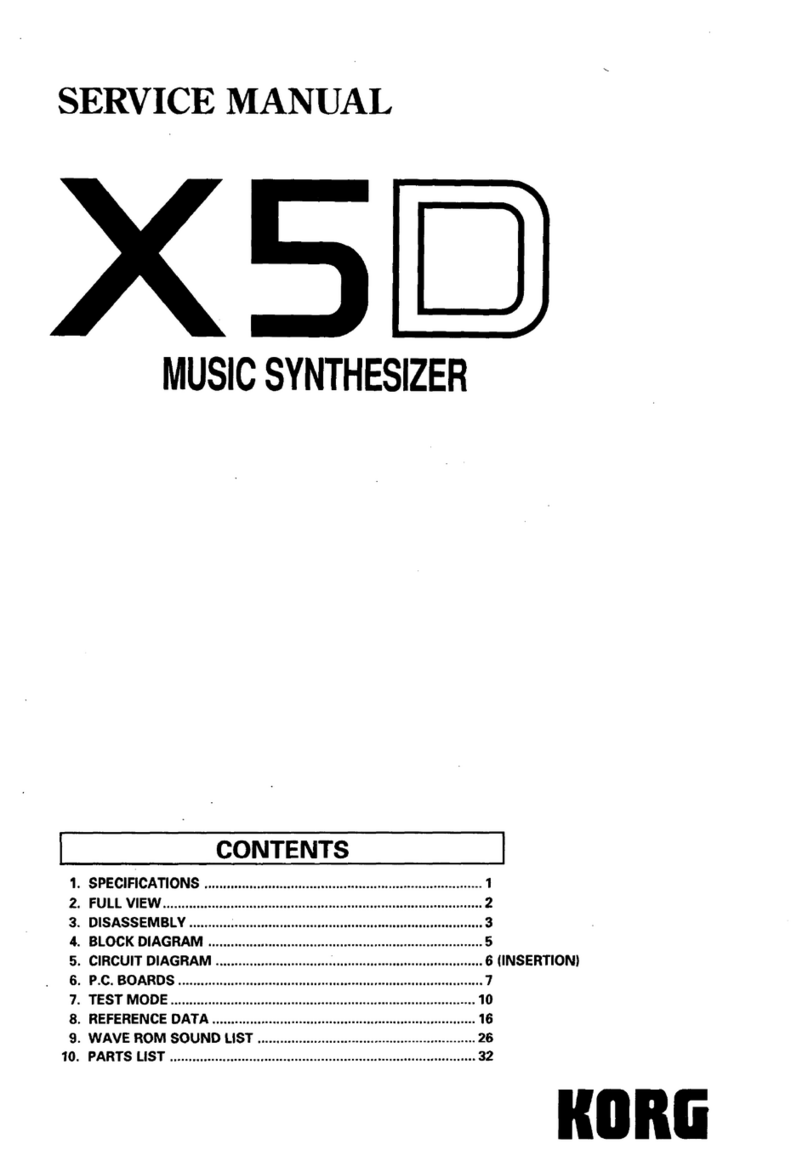
Korg
Korg X5D User manual
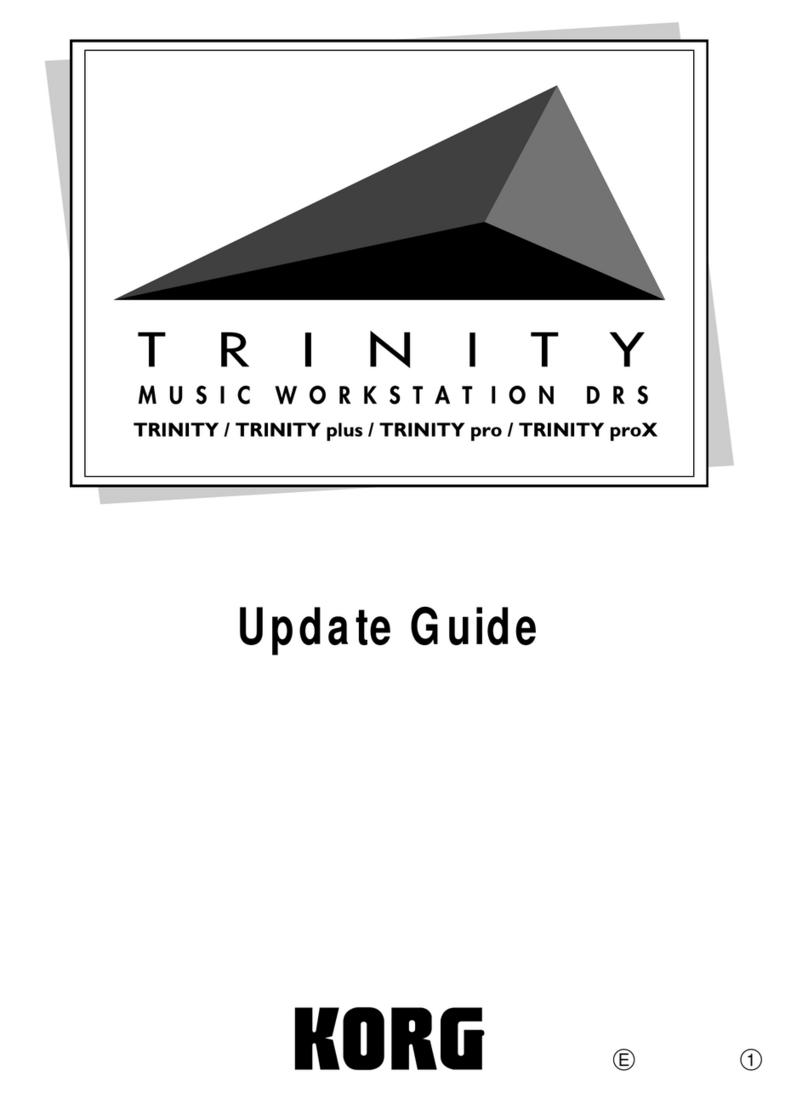
Korg
Korg Trinity plus General instructions
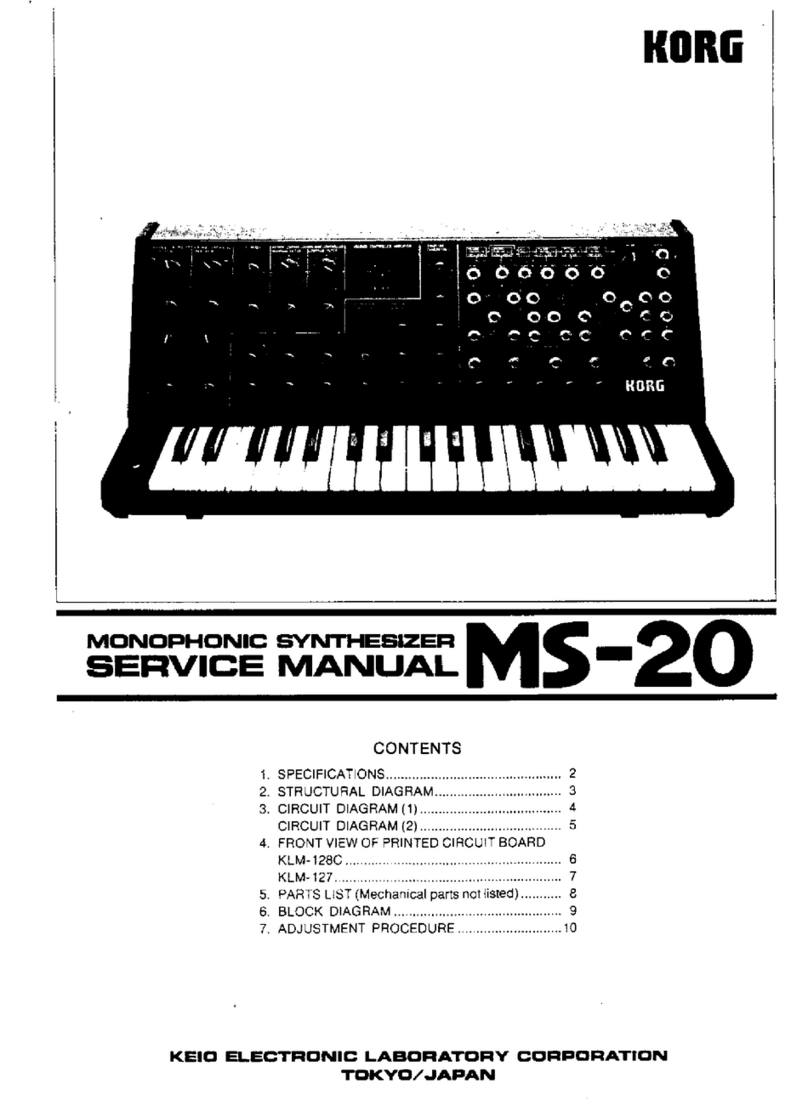
Korg
Korg MONOPOLY POLYSIX MS-20 User manual
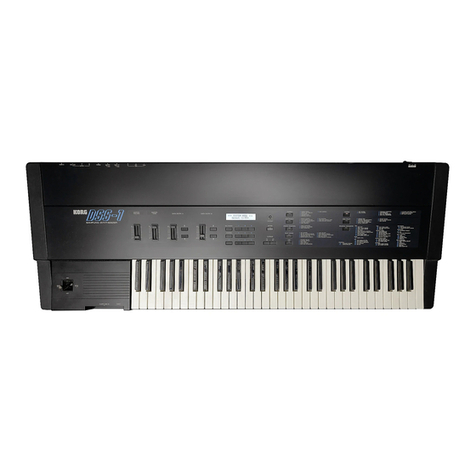
Korg
Korg DSS-1 User manual
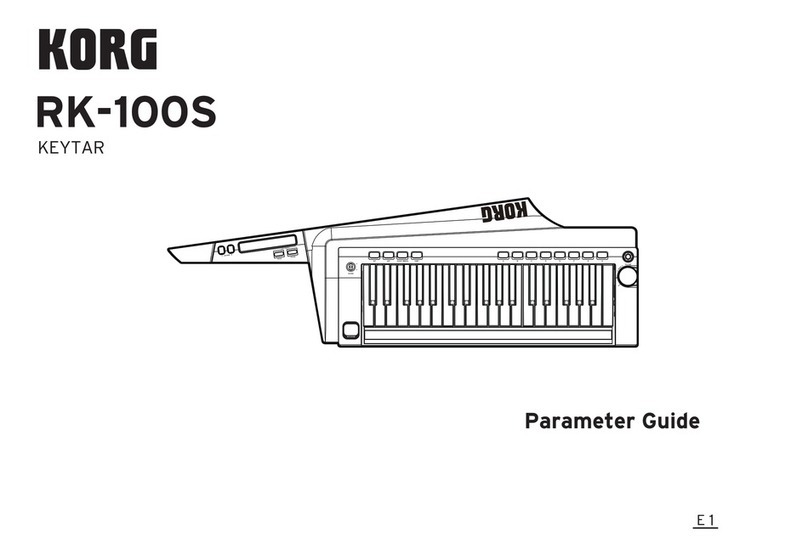
Korg
Korg RK-100S User manual
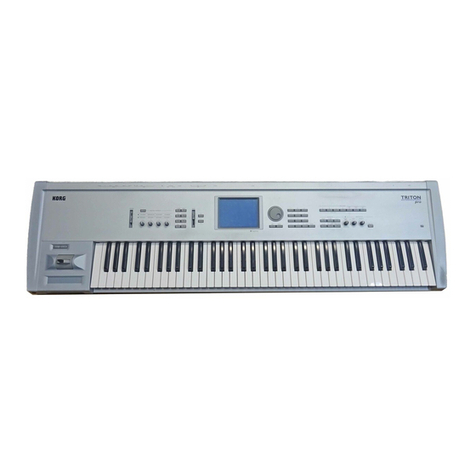
Korg
Korg Triton Studio User manual
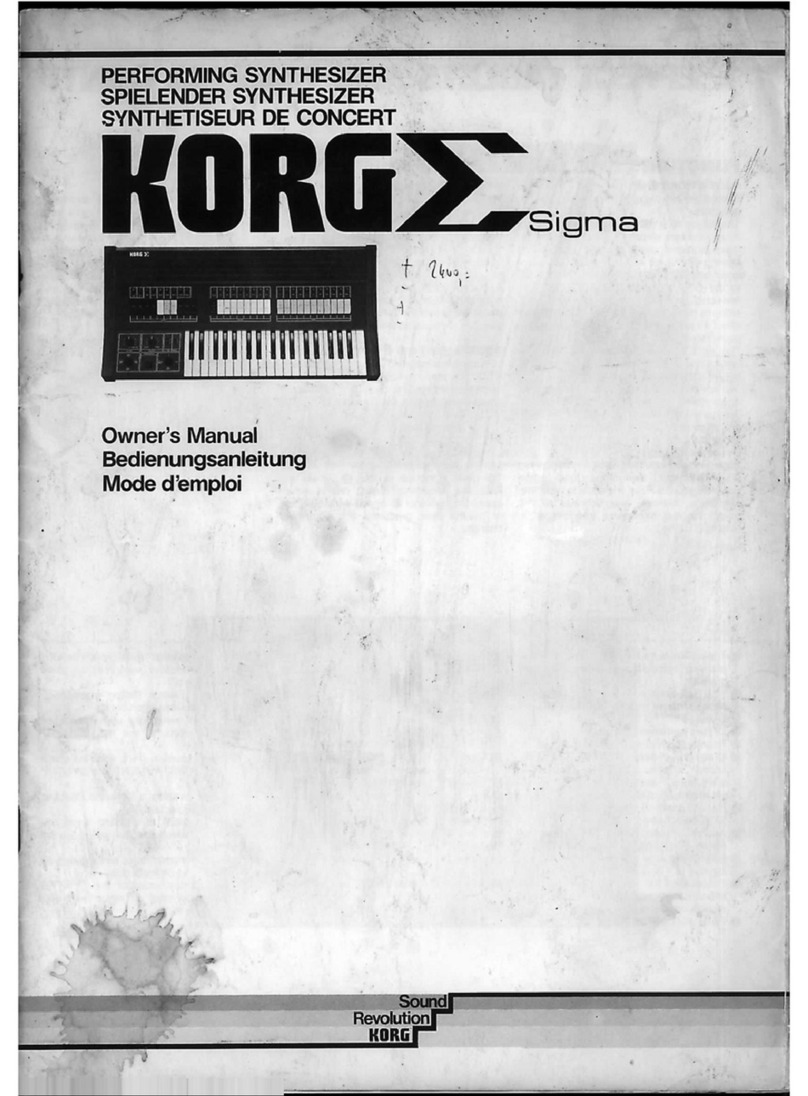
Korg
Korg Sigma User manual
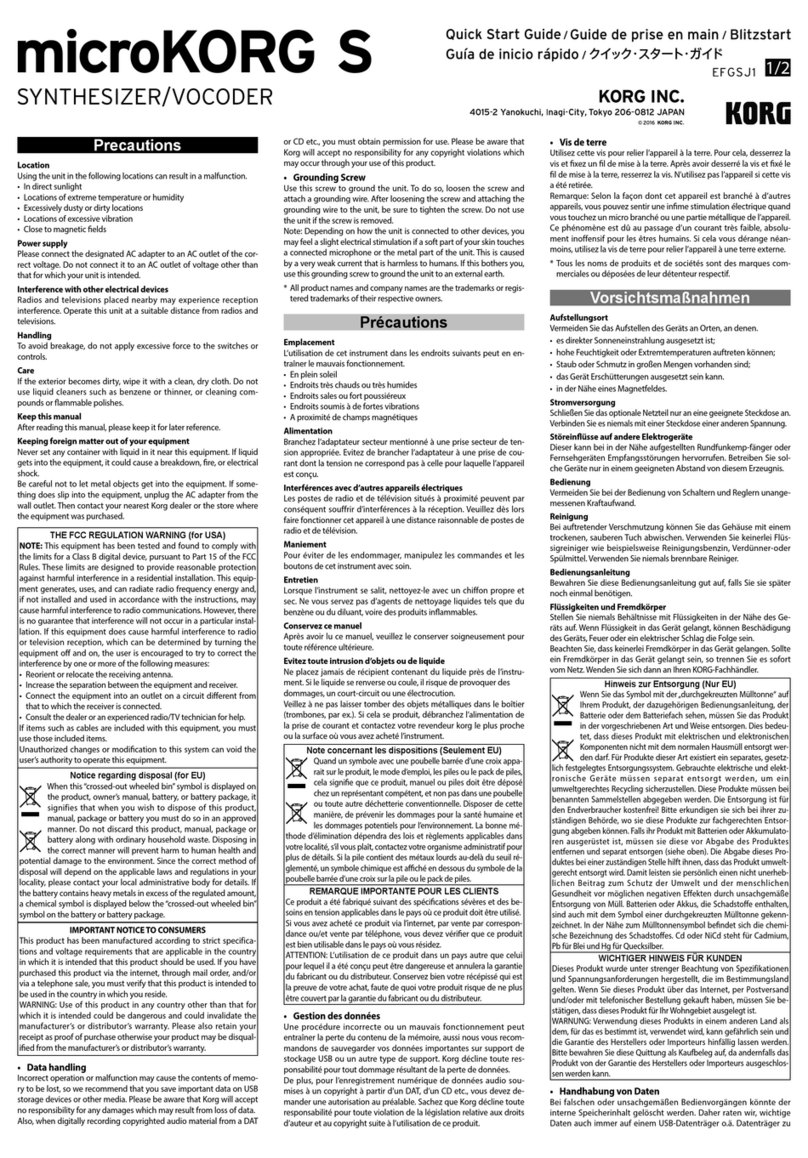
Korg
Korg MICROKORG S User manual

Korg
Korg VOLCA FM Technical manual

Korg
Korg Wavestation User manual




